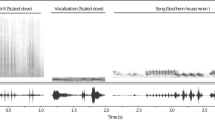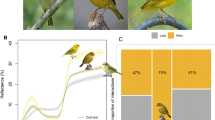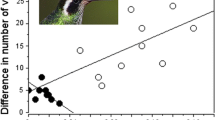Summary
Status signalling in juvenile male Willow TitsParus montanus was studied by observing the outcome of interactions of birds with different size of their black throat badge, and by manipulating the size of their badge. The bird with the largest throat badge was the dominant one in all dyads studied (N=25), and the relative rank position of the males was positively correlated with the size of their badge. The badge size explained about 95% of the variation in the birds' dominance rank. When confronting juvenile males with a stuffed Willow Tit mounted close to a feeder placed in an aviary, there was found a negative correlation between the size of the badge of the males and the time from they were released till they visited the feeder. After subordinate birds from seven earlier dyads got their throat badge artificially increased, the originally dominant bird reacted submissively and tried to avoid the bird with a larger dyed badge, that temporary had increased its rank position. Our data support the status signalling hypothesis.
Zusammenfassung
Durch Beobachtung von Interaktionen zwischen jungen Männchen der Weidenmeise (Parus montanus) mit schwarzem Kehlfleck unterschiedlicher Größe und durch experimentelle Veränderung der Kehlfleckgröße wurde untersucht, ob durch den Kehlfleck der Dominanzstatus eines Vogels signalisiert wird. In allen untersuchten Paarvergleichen war der Vogel mit dem größten Kehlfleck dominant (N=25); die relative Rangposition eines Männchens war mit der Kehlfleckgröße positiv korreliert. Kehlfleckgröße erklärte 95% der Variation in der Rangstellung. Wurden junge Männchen mit einem Stopfpräparat konfrontiert, das in einem Käfig nahe der Futterstelle montiert war, ergab sich eine negative Korrelation zwischen der Kehlfleckgröße der Versuchsmännchen und dem Intervall zwischen ihrem Einsetzen in den Käfig und dem Besuch der Futterstelle. Nachdem die Kehlflecke von unterlegenen Männchen in sieben der Paarversuche künstlich vergößert worden waren, reagierte das vorher dominante Männchen unterwürfig und versuchte den Vogel mit dem durch Färbung vergrößerten Kehlfleck zu meiden, der dadurch vorübergehend seine Rangstellung verbesserte. Unsere Ergebnisse unterstützen die „status signalling“-Hypothese.
Similar content being viewed by others
Literature
Dawkins, R., &J. R. Krebs (1978): Animal signals: information or manipulation? In:Krebs, J. R., &N. B. Davies, Behavioural Ecology: an Evolutionary Approach: 282–309.
Dixon, K. L. (1963): Some aspects of social organization in the Caroline chickadee. Proc. XIII Int. Orn. Congr.: 240–258.
Eckert, C. G., &P.J. Weatherhead (1987): Owners, floaters and competitive asymmetries among territorial redwinged blackbirdsAgelaius phoeniceus. Anim. Behav. 35: 1317–1323.
Ekman, J. (1988): Subordination costs and group territoriality in wintering Willow Tits. Acta XIX Int. Orn. Congr.: 2372–2381.
Ditto (1990): Alliances in winter flocks of willow tits; effects of rank on survival and reproductive success in male-female associations. Behav. Ecol. Sociobiol. 26: 239–245.
Ditto,G. Cederholm &C. Askenmo (1981): Spacing and survival in winter groups of willow titParus montanus and crested titP. cristatus — a removal study. J. Anim. Ecol. 50: 1–9.
Fugle, G. N., &S. I. Rothstein (1987): Experiments on the control of deceptive signals of status in white-crowned sparrows. Auk 104: 188–197.
Grafen, A. (1990): Biological signals as handicaps. J. theor. Biol. 144: 517–546.
Haftorn, S. (1982): Variation in body measurements of the Willow TitParus montanus, together with a method for sexing live birds and data on the degree of shrinkage in size after skinning. Fauna norv. Ser. C, Cinclus 5: 16–26.
Hogstad, O. (1987): Social rank in winter flocks of Willow TitsParus montanus. Ibis 129: 1–9.
Ditto (1989 a): Winter floaters in Willow TitsParus montanus — a matter of choice or making the best of a bad situation? In:Blondel, J., et al., Population Biology of Passerine Birds, an Integrated Approach: 415–421.
Ditto (1989 b): The role of juvenile willow tits,Parus montanus, in the regulation of winter flock size: an experimental study. Anim. Behav. 38: 920–925.
Holberton, R. L., K. P. Able &J. C. Wingfield (1989): Status signalling in dark-eyed juncos (Junco hyemalis): plumage manipulations and hormonal correlates of dominance. Anim. Behav. 37: 681–689.
Jackson, W. M., S. Rohwer &R. L. Winnergrad (1988): Social status signalling isabsent within age and sex classes of Harris' sparrows. Auk 424–427.
Järvi, T., &M. Bakken (1984): The function of the variation in the breast stripe of the great tit (Parus major). Anim. Behav. 32: 590–596.
Ketterson, E. D. (1979): Status signalling in dark-eyed juncos. Auk 96: 94–99.
Koivula, K., &M. Orell (1988): Social rank and winter survival in the willow titParus montanus. Orn. Fenn. 65: 114–120.
Laaksonen, M., &E. Lehikoinen (1976): Age determination of Willow and Crested TitParus montanus andP. cristatus. Orn. Fenn. 53: 9–14.
Maynard Smith, J., &G. A. Parker (1976): The logic of asymmetric contests. Anim. Behav. 24: 159–175.
Møller, A. P. (1987): Variation in badge size in male house sparrowsPasser domesticus: evidence for status signalling. Anim. Behav. 35: 1637–1644.
Rohwer, S. (1975): The social significance of avian winter plumage variability. Evolution 29: 593–610.
Ditto (1977): Status signalling in Harris sparrows: some experiments in deception. Behaviour 61: 107–129.
Ditto, &F. C. Rohwer (1978): Status signalling in Harris Sparrows: Experimental deception achieved. Anim. Behav. 26: 1012–1022.
Smith, S. (1976): Ecological aspects of dominance hierarchies in black-capped chickadees. Auk 93: 95–107.
Svensson, L. (1984): Identification Guide to European Passerines. Stockholm.
Watt, D. J. (1986 a): A comparative study of status signalling in sparrows (genusZonotrichia. Anim. Behav. 34: 1–15.
Ditto (1986 b): Relationships of plumage variability, size and sex to social dominance in Harris' sparrows. Anim. Behav. 34: 16–27.
Whitfield, D. P. (1986): Plumage variability and territoriality in breeding turnstoneArenaria interpres: status signalling or individual recognition? Anim. Behav. 34: 1471–1482.
Wilson, J. D. (1992): A re-assessment of the significance of status signalling in populations of wild great tits,Parus major. Anim. Behav. 43: 999–1009.
Author information
Authors and Affiliations
Rights and permissions
About this article
Cite this article
Hogstad, O., Kroglund, R.T. The throat badge as a status signal in juvenile male willow titsParus montanus . J Ornithol 134, 413–423 (1993). https://doi.org/10.1007/BF01639832
Published:
Issue Date:
DOI: https://doi.org/10.1007/BF01639832




